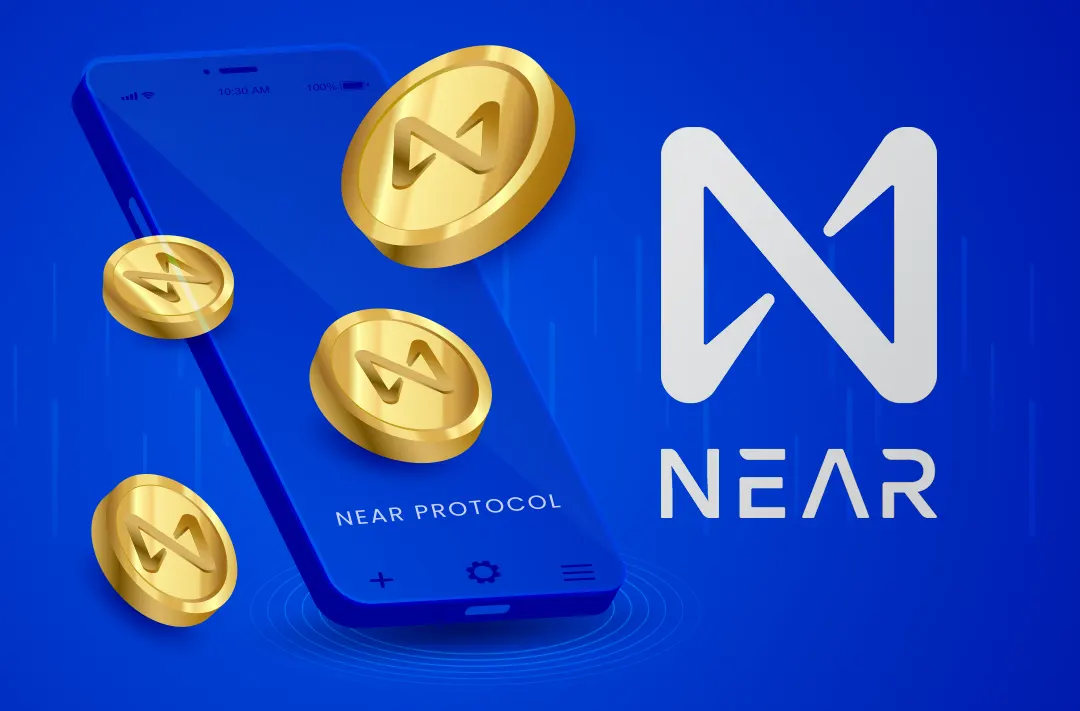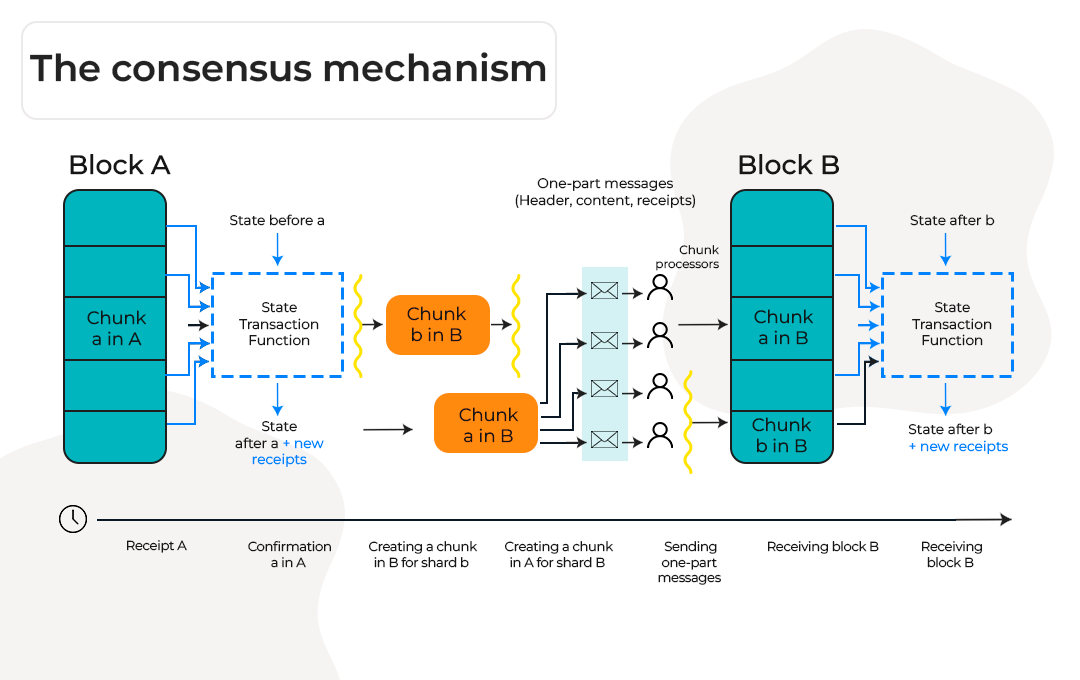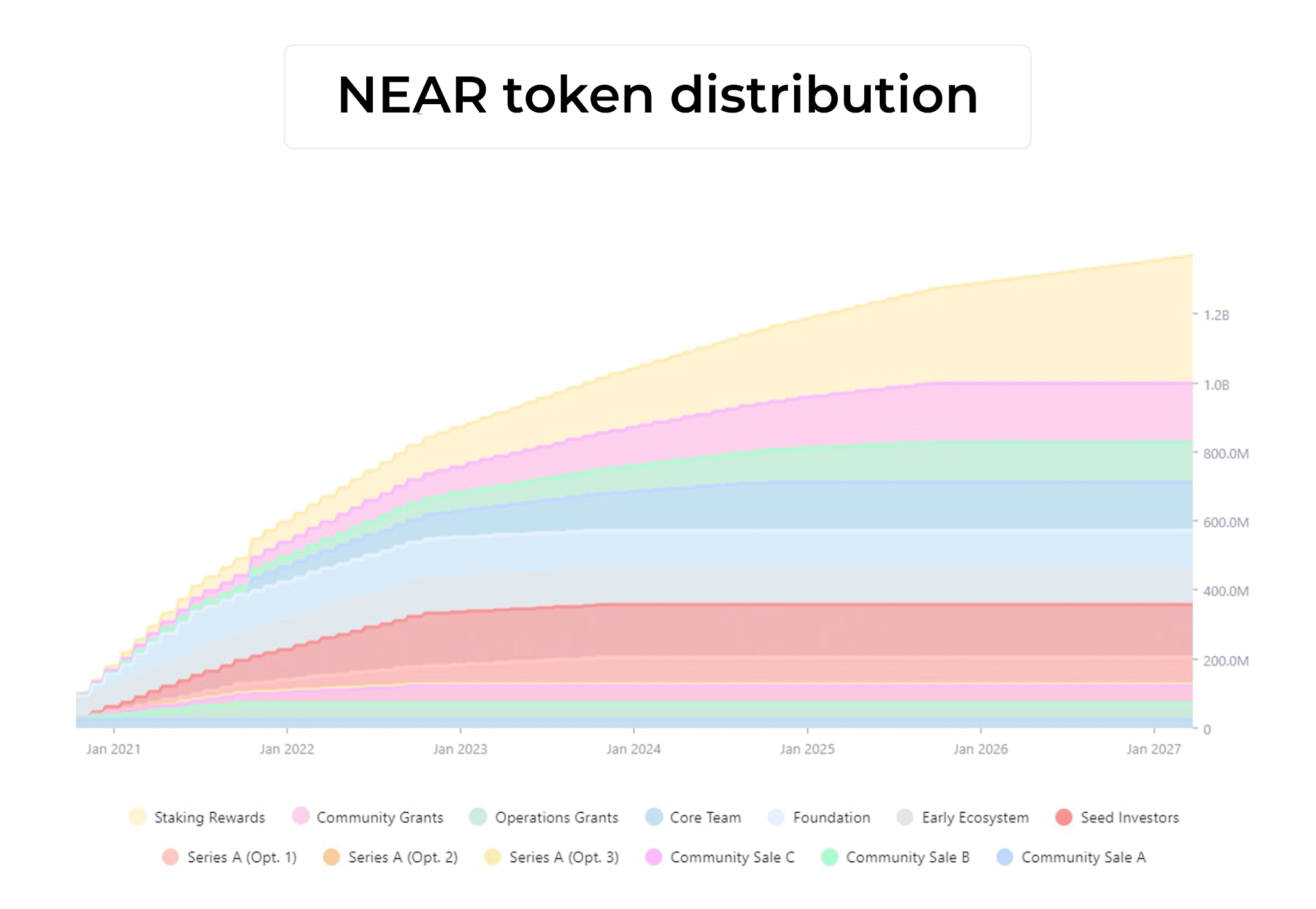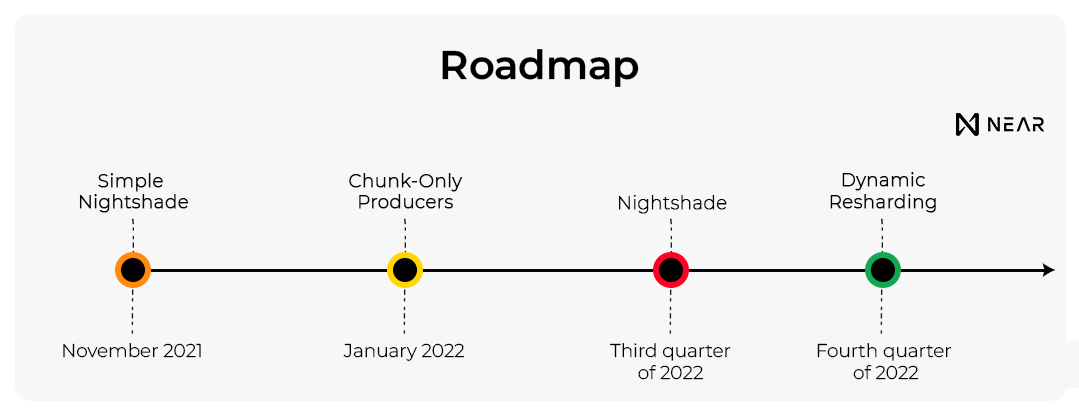What is NEAR Protocol? Revealing the features of the project in simple words
NEAR Protocol is a blockchain platform for decentralized applications (dApps)

11.03.2022
3892
8 min
1
. It uses the Proof-of-Stake consensus mechanism and has a segmented architecture for scaling network throughput. The project positions itself as a competitor to Ethereum, focusing on convenience for developers and users. The blockchain uses the $NEAR token of the same name to pay fees and other transactions.
Many dApps developers have recently switched from the Ethereum blockchain to the NEAR. They were attracted by the lower fees, high speed of transactions, and wide opportunities for the development of their applications, and more and more investors are becoming interested in the project. What is remarkable about NEAR Protocol, and how it can compete with Ethereum, is explained in this article.
Background
NEAR Protocol was originally designed as a machine learning platform. The project was launched in 2017 by two Russian programmers, Illia Polosukhin and Alexander Skidanov; it was called NEAR.ai at that time. Later, when the developers learned about smart contracts and cryptocurrency, they began to study blockchain to create their decentralized applications.
Polosukhin and Skidanov concluded that no blockchain platform met their requirements. They decided to create a scalable platform that would allow developers to fully implement their dApps. They chose the Proof-of-Stake consensus mechanism and named the project NEAR Protocol.
Initially, Alexander Skidanov and Illia Polosukhin were the only people working on the project. Today the NEAR Protocol team, known as Near Collective, numbers over 80 people. The project was officially launched in April 2020, and five months later the community began to manage it.
The company raised about $50 million in investments back at the time of the test network launch. Near Foundation recently announced the closing of another round of funding; the project managed to raise $150 million. Three Arrows Capital, Mechanism Capital, Dragonfly Capital, Andreessen Horowitz (a16z), Jump, Alameda, Zee Prime, and Amber Group invested in the project.
Read more about NEAR Protocol
The network participants
The platform focuses on the comfort of users, offering them a convenient web interface and navigation. This approach allows you to quickly start using the blockchain without studying the theory.
NEAR provides developers with a wide range of tools for creating and testing applications. The blockchain supports smart contracts written in Rust and AssemblyScript. More common programming languages are planned to be added in the future. To attract developers, the platform pays royalties to those who have contributed much to the development of the project.
NEAR is also working on the implementation of the Ethereum Virtual Machine (EVM). This will allow developers to migrate their EVM applications to the NEAR blockchain almost unchanged.
Scalability
While Ethereum is struggling with scalability issues with Layer 2 solutions, NEAR developers have created a project with a different architecture. The blockchain uses a segmentation or sharding method called “Nightshade,” which increases the network throughput. The same solution is used in Ethereum 2.0.
This method is related to the functions of nodes: transaction processing and data storage. We talked more about the structure of the blockchain in our article. Sharding is the division of network nodes into several segments (shards). With this architecture, nodes do not process the entire transaction pool, but only the one that belongs to their segment. In this way, shards can perform calculations in parallel with each other, reducing the load on the network.
Because the network is fragmented, some validators check so-called “chunks,” a set of transactions from a segment. The list of transactions in each block is divided into several such chunks. That is, a block of the network logically contains information from all the shards, but physically they store only the hash of the chunk, in which the information about transactions is encrypted.
This speeds up the network because when a block is downloaded, network participants decrypt only the chunk that is needed for the selected segment. As the number of transactions increases, the network begins to use more chunks and validators, without slowing down.
With this architecture, NEAR is capable of handling up to 100 000 transactions per second. Each segment of the chain runs in parallel with each other, so the network does not suffer from overloads.
Consensus mechanism
The developers chose Proof-of-Stake (PoS) as the consensus algorithm. In all major aspects, it works the same way as other PoS blockchains, but because of network segmentation, a new function has appeared for validators.

NEAR Protocol uses an auction system and selects new validators every "epoch" (approximately 12 hours). To become validators, users must block their NEAR tokens in the staking pool. Those who do not want to manage the node can vote with the same tokens for any candidate and be rewarded by that validator.
The Doomslug mechanism is used to create blocks. When validators vote to approve blocks, their votes are weighted based on how many tokens they have in their staking pools. The reward for staking depends on the number of coins blocked. After receiving the reward, the validator can choose how much to keep and how much to give to the delegates.
The $NEAR token
The platform's native tokens are mainly used to pay transaction fees and as a management tool during staking. NEARs are also paid as a reward to stakeholders. In addition, developers who create smart contracts receive part of the fee. The network creates 5% of new coins every year, 90% of which go to rewards for stakeholders, and the rest is allocated to project development.
The fees that are paid for the transactions in each blockchain are split in two. 70% is received by the owner of the smart contract, and the remaining part is burned. That is, with a large number of transactions, the rate at which tokens are burned may exceed the rate at which new tokens are created, and the network will become deflationary.
Also, all network participants, including applications, must pay a fee for data storage. That is, for each kilobyte of information, you need to have a certain number of tokens on your account.

The NEAR protocol can support “wrapped” tokens from other blockchains, as well as NFT. The platform has a bridge with Ethereum configured, which allows users to convert ERC-20 tokens from Ethereum to $NEAR. The blockchain also has its own wallet “Near Wallet.”
Basic data:
- Ticket: NEAR
- Blockchain: NEAR Protocol
- Token standard: NEP-141, ERC-20.
- Contract: 0x85F17Cf997934a597031b2E18a9aB6ebD4B9f6a4 (ERC-20)
- Turnover bid 473 222 631
- Total supply 1 000 000 000.
- The maximum stock is 1 000 000 000
The NEAR Accounts
The NEAR blockchain has proposed a new approach to user accounts. Instead of the hash of the public key, NEAR uses a human-readable identifier. It looks something like this: “getblock.near.” Such a key is much easier to remember than a long set of random characters.
Users can also create an unlimited number of subaccounts. For example, “token.getblock.near” or “nft.getblock.near.” If desired, you can create an “implicit” account that looks similar to Bitcoin addresses.
NEAR has provided accounts for developers. You can use them to test and configure smart contracts.
Projects on the platform
In total, 138 projects have been built on Near in different categories, including 54 dApps, 19 DeFi, 20 NFT, and 8 DAO.
For comparison, Solana has 423 projects in different categories, Ethereum has 220 DeFi projects, and BSC has 241 DeFi projects.
Mintbase
Mintbase is an NFT marketplace. On the platform, users can buy, create non-fungible tokens, and put them up for sale through the NearNFT trading platform or any other marketplace.
Mintbase switched from Ethereum to Near due to high fees caused by network congestion. The marketplace announced the change of platform when the fee for creating a store with tokens increased to hundreds of dollars in ETH.
Ref Finance
Ref Finance is one of the main projects in the ecosystem of decentralized finance on the NEAR protocol. Its main goal is to combine the main components of DeFi, namely the decentralized exchange (DEX) and lending protocols into a single synchronous platform.
DEX from Ref Finance provides automatic trading without authorization between the native NEAR token and intermediate tokens through liquidity pools managed by smart contracts.
Hash Rush
This is a NEAR blockchain-based, real-time strategy game in which players earn cryptocurrency and other rewards. Players can trade valuable items and resources. Hash Rush, like Mintbase, was originally created on Ethereum, but a large number of transactions and high fees forced the developers to change the blockchain to NEAR Protocol.
Roadmap
In December 2021, NEAR completed Phase 0 of the Simple Nightshade of its roadmap toward a fully segmented blockchain.

- Phase 0: Simple Nightshade - the team launched Phase 0 in November 2021. It is now complete, a partial segmentation of the blockchain into 4 shards was carried out during this period.
- Phase 1: Chunk-Only Producers - the team launched Phase 1 in January 2022. During this period, the blockchain will implement EVM and improve the chunk system.
- Phase 2: Nightshade - improving accessibility for validators. NEAR plans to implement this phase in the third quarter of 2022.
- Phase 3: Dynamic Resharding - it is planned to switch to a fully segmented and decentralized blockchain in the fourth quarter of 2022.
During its short existence, the NEAR Protocol has been able to achieve great results. More and more projects are opting for a fast, cheap, and scalable blockchain. The protocol has not yet overtaken Ethereum and its Polygon sidechain in popularity.
The blockchain still has some shortcomings, with many users blaming the network for its lack of scalability. But perhaps when the developers complete all phases of the roadmap and fix the flaws, other teams and companies will pay more attention to the NEAR Protocol.
Useful material?
Basics
Why Satoshi Nakamoto’s technical manifesto for a decentralized money system matters
Oct 31, 2022
Basics
Experts evaluated the development prospects of the new ecosystem and the investment attractiveness of its token
Oct 20, 2022
Basics
How to track fluctuations correctly and create an effective income strategy
Sep 13, 2022
Basics
Review of the most profitable offers from proven trading platforms
Aug 29, 2022
Basics
The Ethereum Foundation team has published a breakdown of major misconceptions about the upcoming network upgrade
Aug 18, 2022
Basics
What benefits the exchange offers, and what else is in the near future
Aug 4, 2022









 Telegram
Telegram  Twitter
Twitter